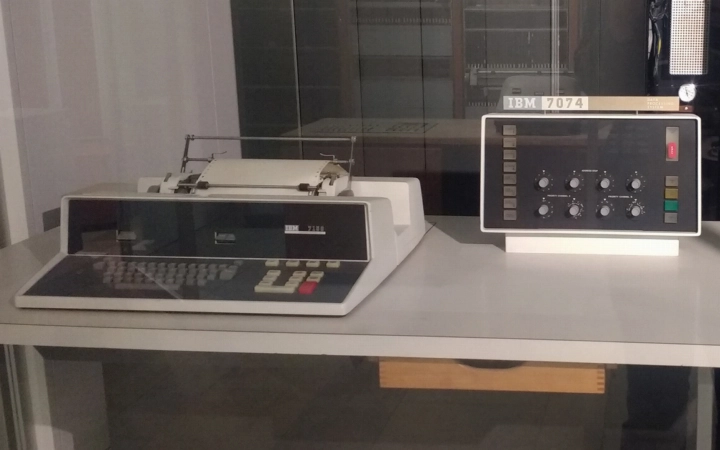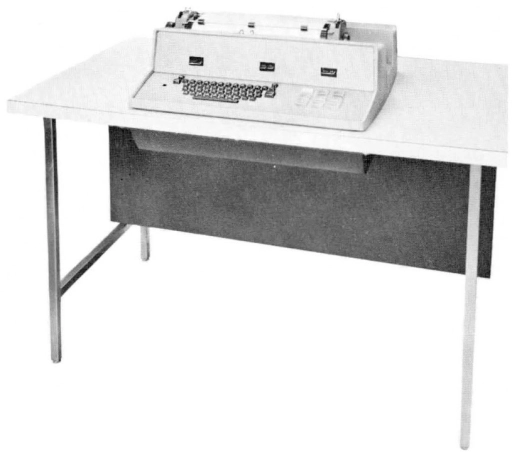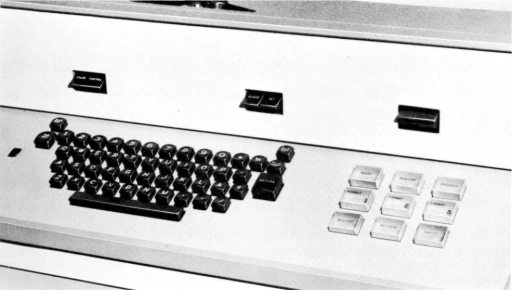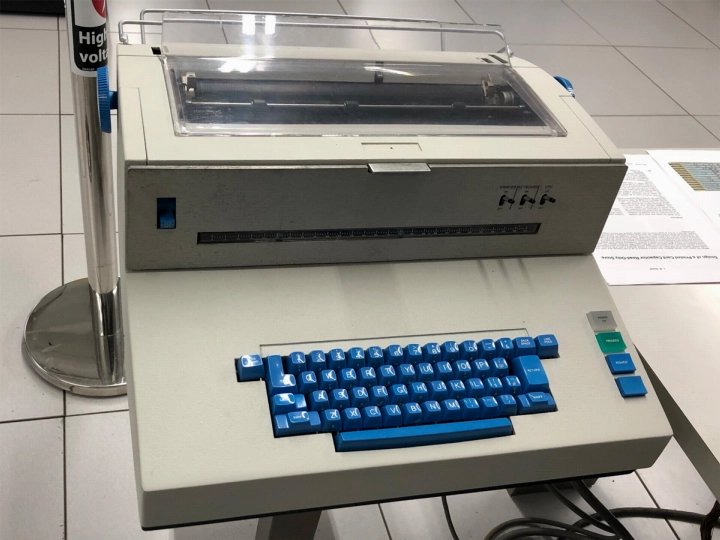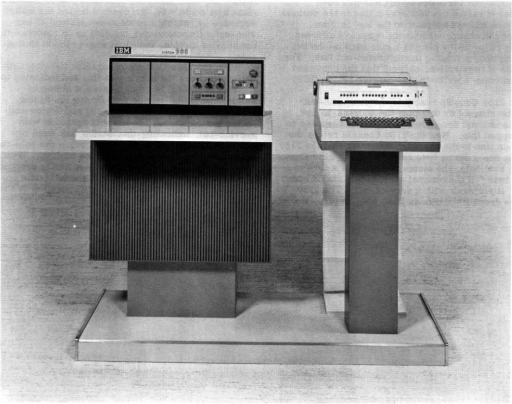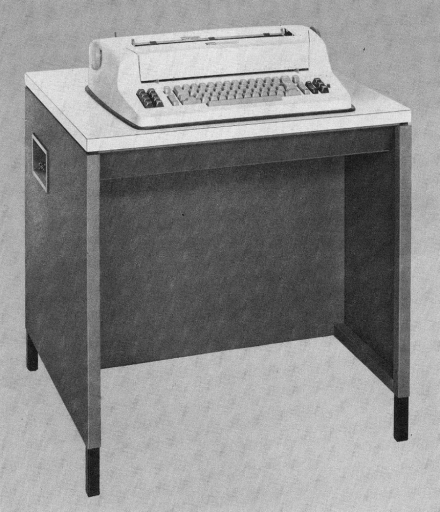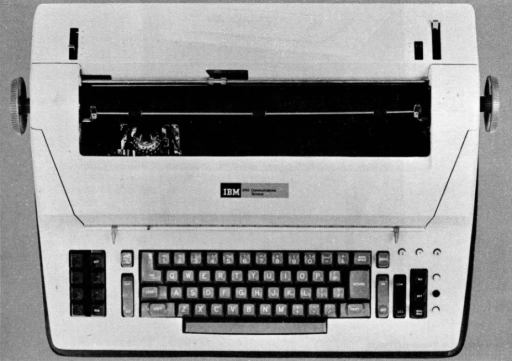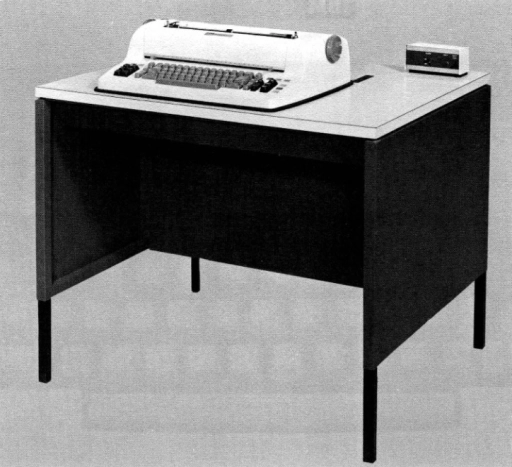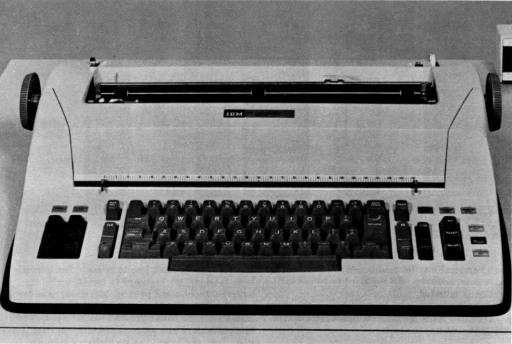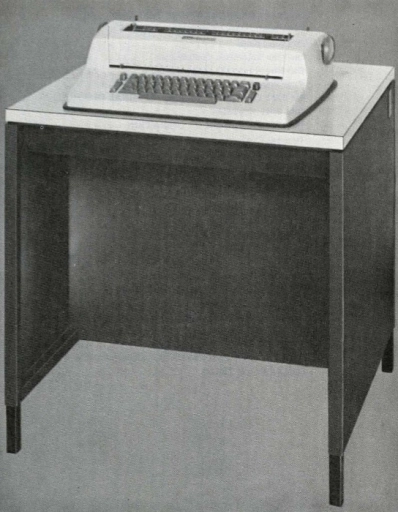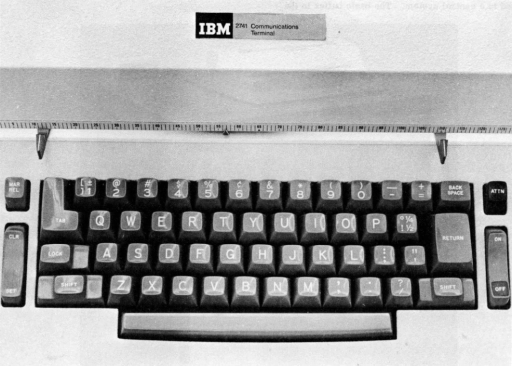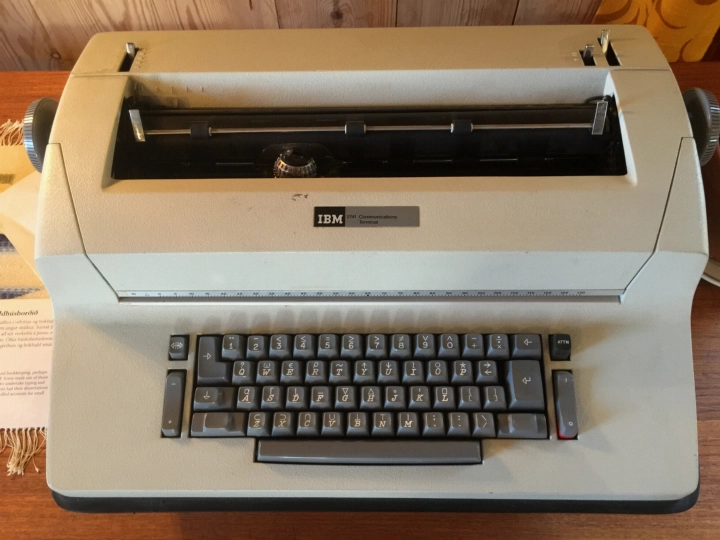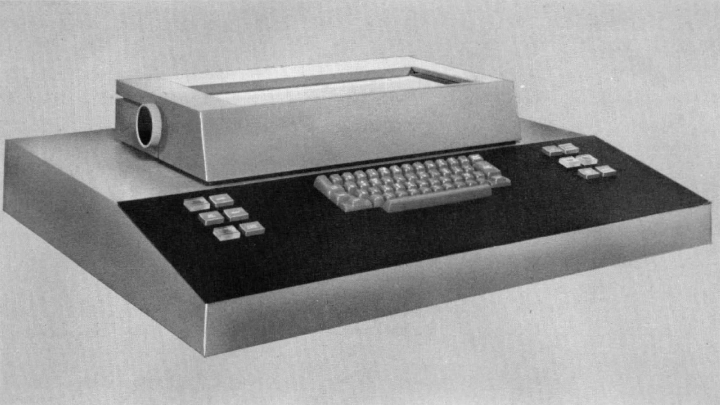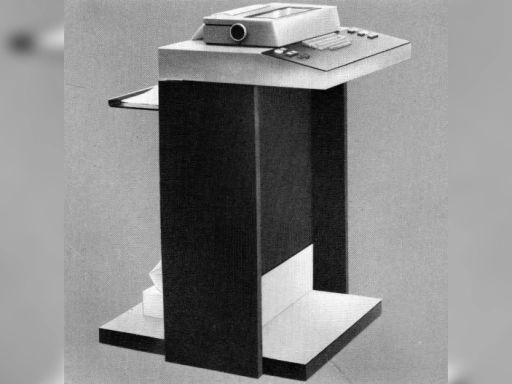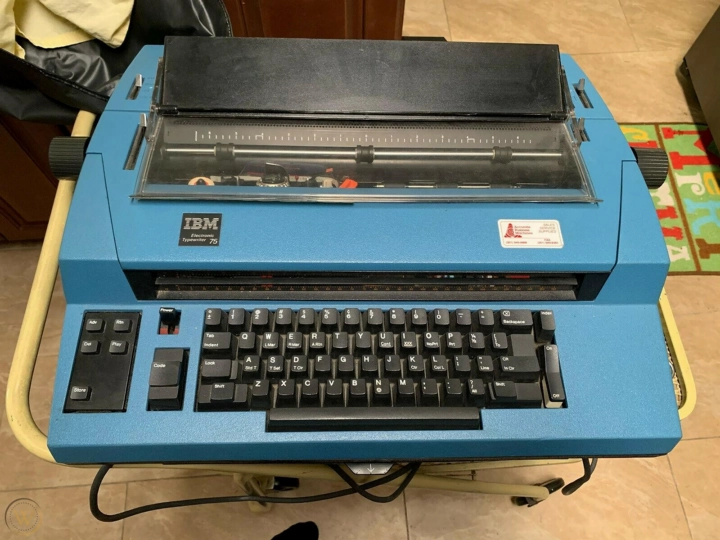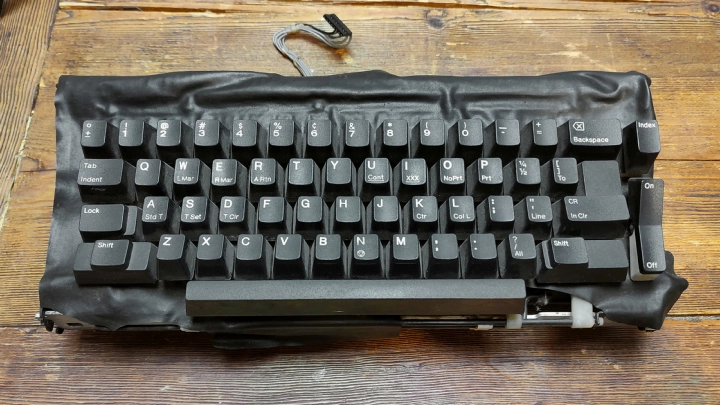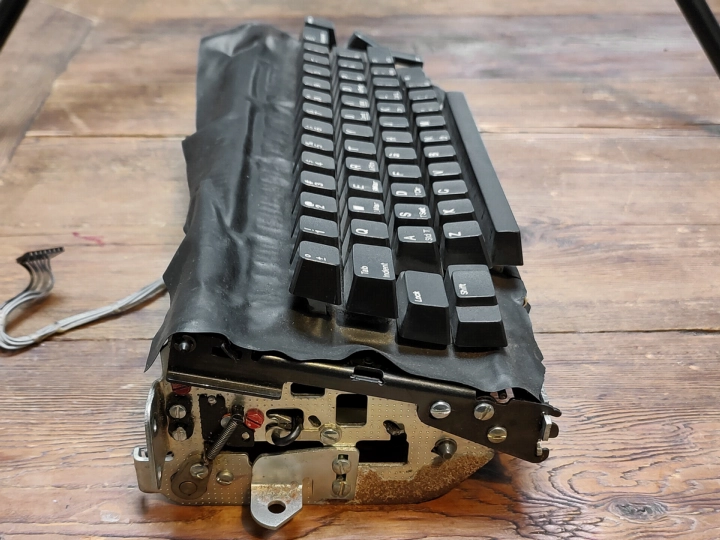IBM's second generation of keyboards
- Updated
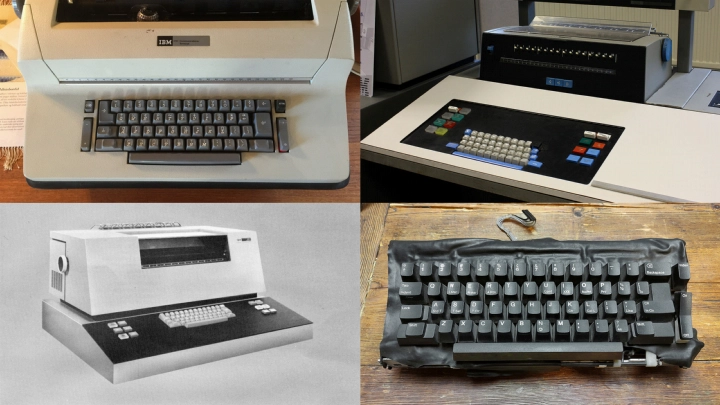
The many typewriter-based keyboards IBM used as so-called "printer-keyboards" were their second generation of keyboards, technically introduced as early as 1958 but became available in numbers during the mid-1960s. With well-known examples such as the IBM 1052 I/O Printer-Keyboard and IBM 2740/2741 Communications Terminals, such keyboards were typically used in a configuration where typing on the keyboard inputs characters in a terminal console whilst also printing out characters and console output through the typewriter mechanism, giving them their "printer-keyboard" name. IBM also mixed in using IBM Card Punch keyboard assemblies for such keyboards, resulting in several types of printer-keyboard categorised by their combination of keyboard assembly and typing element used.
Contents
Types
IBM printer-keyboards are a broad family of keyboards that drew upon various keyboard assemblies and print technologies available at the time to construct a full unit from. IBM never published official distinctions on its printer-keyboard types other than describing the technologies that comprise a given printer-keyboard in sentences, thus four generalised types of printer-keyboards have been invented to quickly describe the technical composition of a given printer-keyboard.
Typewriter type, typewriter print
The typewriter-type, typewriter-print (TT) printer-keyboard is one that's essentially a modified typewriter with no alternative typing technologies introduced. They may or may not also closely resemble the original mass-market typewriter they're based on. For the most part, TTTP printer-keyboards are based on IBM Selectric typewriters and thus use the original Selectric keyboard and 'golfball' typing mechanism for operation. However, many such printer-keyboards are modified such that keyboard and printing can be separate operations. Before the release of IBM Selectric, IBM was known to use its typebar-era typewriters such as the IBM Model A and B Electric Typewriters for printer-keyboard usage.
Bail keypunch type, typewriter print
The bail keypunch-type, typewriter-print (BKT) printer-keyboard is one that marries an IBM Card Punch keyboard assembly to a typewriter-sourced typing element. IBM Card Punch keyboards such as the IBM 024 and 029 series use a system of contact bails known as a Keyboard Permutation Unit for key-stroke sensing, which allows the keyboard assembly to be self-contained as its own discrete keyboard. This is then used to electrically signal a connected printer. In most cases, the printing component is based on the IBM Selectric typing mechanism.
Elastic diaphragm type, dot matrix print
The elastic diaphragm-type, dot matrix-print (DKDM) printer-keyboard is one that marries an IBM Elastic Diaphragm encoded keyboard assembly to a dot matrix printer. The sole known example is the IBM 3215 Console Printer-Keyboard, during which time no IBM typewriter used a similar dot matrix printing element. The system was known for being bulky but able to print much faster than a Selectric-based printer.
Reed keypunch type, typewriter print
After the heyday of the printer-keyboard, IBM revisited a similar concept with its models 50, 60 and 75 IBM Electronic Typewriter that married a keypunch-style keyboard with magnetic reed switches for key-stroke sensing to an IBM Selectric typing element powered by solenoids. This is considered a reed keypunch-type, typewriter-print (RKT) system.
| Type | First appeared | Type |
|---|---|---|
| 7150 Console Typewriter & Operating Keyboard | 1958 | Model B type, Model B print |
| 7900 Inquiry Station Typewriter Keyboard | 1958 | Model B type, Model B print |
| 1052 I/O Printer-Keyboard | 1963 | Bail keypunch type, Selectric print |
| 1816 Printer-Keyboard | 1964 | Bail keypunch type, Selectric print |
| 1130 Computing System Console Keyboard | 1965 | Bail keypunch type, Selectric print |
| 2740 Communications Terminal | 1965 | Selectric type, Selectric print |
| 2741 Communications Terminal | 1965 | Selectric type, Selectric print |
| 2152 Printer-Keyboard | 1968 | Selectric type, Selectric print |
| 5471 Printer-Keyboard | 1969 | Selectric type, Selectric print |
| 3210 Console Printer-Keyboard | 1970 | Bail keypunch type, Selectric print |
| 3215 Console Printer-Keyboard | 1970 | Elastic diaphragm type, dot matrix print |
| 3793 Printer-Keyboard | 1974 | Selectric type, Selectric print |
| Electronic Typewriter Models 50, 60 and 75 | 1978 | Reed keypunch type, Selectric print |
The IBM 7150 was a multi-purpose input/output component for the IBM 7070 Data Processing System family first introduced in 1958[6]. The 7150 (and its 7900 sibling seen below) was amongst the earliest known printer-keyboards and comprised of two separate input devices within one housing - the Console Typewriter and the Operating Keyboard. The Console Typewriter was used for various purposes including inputting and outputting data or displaying the contents of the system's instruction counter, program register or core-storage words, but it could also be used as a normal typewriter as needed. At the time, the current IBM Electric Typewriter series was the Model B and thus the likely donor for the keyboard assembly and type mechanism, albeit modified to output type in single-case only. The Operating Keyboard is the series of larger keys to the right of the Console Typewriter featuring status, control and operation keys[7].
The IBM 7900 was the querying input/output component for the IBM 7070 Data Processing System family first introduced in 1958[6]. The 7900 (and its 7150 sibling seen above) was amongst the earliest known printer-keyboards and was used for sending messages to a host 7070, which would then be processed by a stored program routine that would reply using the type mechanism. At the time, the current IBM Electric Typewriter series was the Model B and thus the likely donor for the keyboard assembly and type mechanism, albeit modified to output type in single-case only. Alongside the typewriter keyboard, the 7900 also sports several operating keys and lights[5].
The IBM 1052 was the console component of the IBM 1050 Data Communications System from 1963. The IBM 1050 could send and receive data to and from another 1050 terminal or an IBM 1400, 7000 or System/360 series computer[9]. The printer-keyboard itself is a mating of a Selectric printer and an IBM 024/026 Card Punch keyboard assembly. The connection between the printer and keyboard is facilitated by a console control unit, which also allows both components to operate independently[%SY22-2909-2%]. 1052 was available in various configurations with differing amounts of 1x4 keys beside the alphanumeric keyboard and toggle switches on the upper front-facing panel. The variants could be lettered or numbered such as the 1052a, 1052-3, 1052-5, 1052-6, 1052-7 and 1052-8.
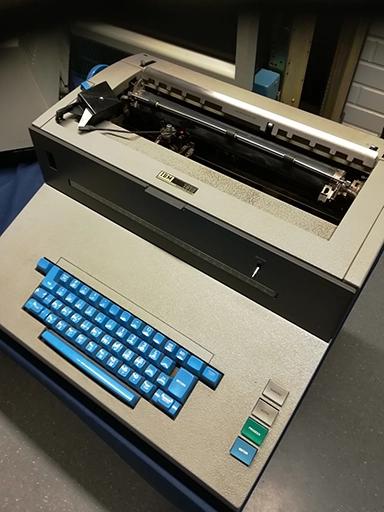
The IBM 1816 was the printer-keyboard component for the IBM 1800 Data Acquisition and Control System introduced in 1964. It seems to be essentially the same as 1052, making it a likely keypunch-Selectric keyboard. Known uses of the IBM 1800 at large include Buick, CERN, Ford, NASA and the United States Air Force[11].
1130 Computing System Console Keyboard (1965)
More information: IBM 1130 Computing System Console Keyboard
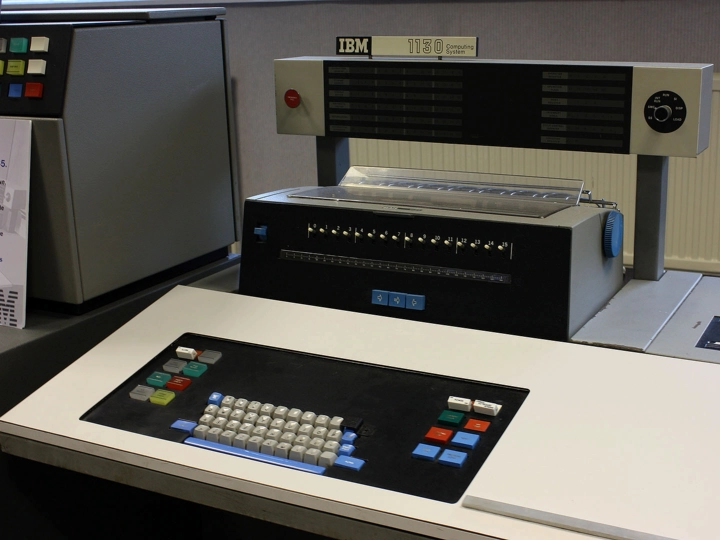
The IBM 1130 Computing System was a low-cost computer intended for price-sensitive and computing-intensive technical markets like education and engineering. It was announced in February 1965[12] and comes in the form of a desk-like setup containing an IBM 1131 Central Processing Unit, an IBM 029 Card Punch based keyboard and a Selectric-based IBM 1053 Console Printer. The console keyboard was used for entering data and instructions into the system's core storage[13].
The IBM 2740 was a Selectric typewriter based printer-keyboard released in July 1965 alongside the IBM 2741[12]. Both the 2740 and 2741 feature an IBM 72 I/O Typewriter using then-end Solid Logic Technology (SLT) circuitry and the ability to be used as a standard typewriter as needed[16]. The IBM 2740 could communicate with other terminals or a computer such as an IBM System/360, requiring a common-carrier data set or IBM modem line adapter. The IBM 2740 was available in two models; Model 1 (2740-1) and Model 2 (2740-2). 2740-2 is a buffered version of 2740-1 that can store up to 120 characters and print them for verification before transmission. The IBM 2740 was intended for applications such as payment entry, journal entries, inquiries, administrative messages, file updating and renewals[15]. Visually speaking, 2740-1 and 2740-2 also differed with their non-typewriter keys, which for 2740-1 were small and circular but were rectangular for 2740-2.
The IBM 2741 was a Selectric typewriter based printer-keyboard released in July 1965 alongside the IBM 2740[12]. Both the 2740 and 2741 feature an IBM 72 I/O Typewriter using then-end Solid Logic Technology (SLT) circuitry and the ability to be used as a standard typewriter as needed[16]. Unlike 2740 which could communicate with both other terminals and a computer, 2741 is limited to just communicating with a computer such as an IBM System/360. In fact, its operations are controlled by host computer programming. The IBM 2741 thus lacks a few keys that 2740 has and even uses a different typing element. 2741 was primarily intended for use in the IBM Administrative Terminal System (ATS)[15].
2152 Printer-Keyboard (1968)
The IBM 2152 was a printer-keyboard released for the IBM System/360 Model 20 in October 1968[18]. It is a Selectric-based printer-keyboard mounted onto a table that is cable connected to a System/360 Model 20 CPU and is mainly used as an inquiry station[19]. From 1972, it was also available as an optional component of the IBM 2922 Programmable Terminal, an RPQ of the IBM System/360 Model 20[20].
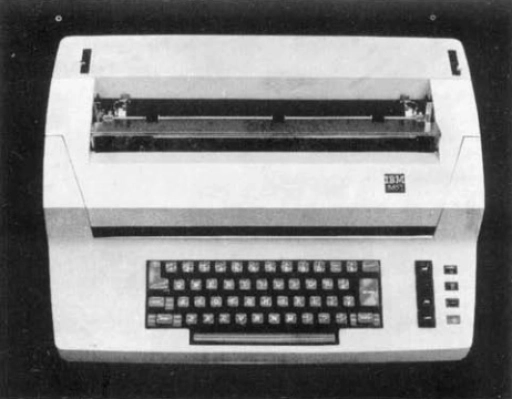
The IBM 5471 is a printer-keyboard available for IBM System/3 computers with an IBM 5444 Disk Storage Drive attached. It was available at the IBM System/3's launch in July 1969[22]. It was designed to perform online inquiries, key entry of data, operator/system communications and operate as a secondary printer. The keyboard and printer components can operate independently of each other under program control[21]. Visually, it resembles an IBM 2741-2 Communications Terminal lacking some keys.
The IBM 3210 was the first of two related console printer-keyboard designs introduced for the IBM System/370 in 1970, alongside 3215. It was used as an I/O console terminal that provides two-way communication between an operator and an attached data processing system. Out of the two, the 3210 mates a keypunch-based keyboard assembly with a then-new Selectric I/O-II printer. It could come in two models that differ in mount and capability. Model 1 is table-mounted and is attached directly to a system CPU with the ability to alter or display data in storage. Model 2 is mounted on its own pedestal and is attached to a CPU via an external signal cable, requiring its own AC power cable and has no alter/display capability[23].
The IBM 3215 was the second of two related console printer-keyboard designs introduced for the IBM System/370 in 1970, alongside the 3210. It was used as an I/O console terminal that provides two-way communication between an operator and an attached data processing system. Out of the two, the 3215 mates an IBM Elastic Diaphragm encoded keyboard assembly with a unique 7x7 dot matrix printing element. This allows for a printing rate of 85 characters per second under program control[3], versus 15.5 characters per second for the Selectric I/O-II based 3210[23]. The 3215 only came in one model unlike the 3210, a pedestal mounted and directly attached console like 3210 Model 1.
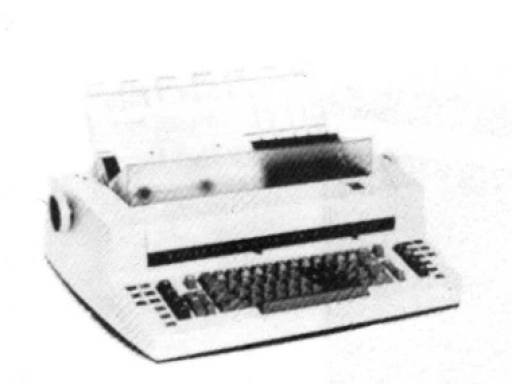
The IBM 3793 is a Selectric I/O II[26] printer-keyboard for the IBM 3790 Communications System of which four such keyboards could be attached to via the IBM 3792 Auxiliary Control Unit[27]. The 3793 was a data entry operator station that also included various control keys, operator guidance indicators and system indicators. The keyboard also included a 10-key arrangement of dual-function keys that could be used for entering numbers as well[25].
The first series of IBM Electronic Typewriters (models 50, 60 and 75) was released in 1978[29] as IBM's first typewriter that was electronic rather than electromechanical - ie, able to perform some amount of internal processing via electronics than rely on mechanical elements. This allowed for features not unlike those found on word processors such as automatic error correction, text underscoring and text centring. They used an electrically-separable keyboard connected to a low-power computer that would use solenoids to drive the Selectric-style print mechanism, contrasting the IBM Selectric's use of mechanical encoding to drive the print mechanism and making the typewriter very similar in setup to a printer-keyboard. The keyboard assembly seems inspired by IBM Card Punch keyboards but uses a series of magnetic reed sensors for key-stroke sensing. The Electronic Typewriter series would ultimately be an intermediary between the IBM Selectric and the Model M-based IBM Wheelwriter typewriter families, but not before these models were replaced by the IBM Electronic Typewriter models 65, 85 and 95 in 1982 that used Model F-based keyboard assemblies instead.
- Oscar.nierstrasz - File:IBM2741.JPG [accessed 2023-01-04]. License/note: CC BY-SA 4.0.
- Martin Skøtt - File:IBM 1130 concole.ms.jpg [accessed 2022-09-04]. License/note: CC BY-SA 2.0.
- IBM - IBM 3215 Console Printer-Keyboard Component Description (#GA24-3550-1) [accessed 2022-09-04].
- Aaron S. Jackson - ECCV 2018, Munich, Germany and Deutsches Museum [accessed 2022-09-15]. License/note: CC with attribution.
- IBM - IBM 7070 Data Processing System Reference Manual (#A22-7003-1) [accessed 2022-09-05].
- Wikipedia - IBM 7070 [accessed 2022-09-16].
- IBM - IBM 7070/7074 Principles of Operation (#GA22-7003-6) [accessed 2022-09-05].
- ComputerGeek7066 - File:IBM 1052.jpg [accessed 2022-09-05]. License/note: CC BY-SA 4.0 (cropped).
- Wikipedia - IBM 1050 [accessed 2021-07-09].
- Heikkonen - donated photo. License/note: CC BY-NC-SA 4.0.
- Engineering and Technology History Wiki - IBM 1800 [accessed 2021-09-16].
- IBM - DPD chronology - 1965 [accessed 2022-09-05].
- The National Museum of Computing - IBM 1130 History [accessed 2022-09-06].
- IBM - IBM 2740/2741 Communications Terminal Operator's Guide (#A27-3001-1) [accessed 2022-09-05].
- IBM - IBM 2740 Model 1, 2740 Model 2 & 2741 Communications Terminal Theory of Operation (#SY27-0013-4) [accessed 2022-09-16].
- IBM - IBM 2740 & 2741 Communications Terminal field engineering announcement (#229-9501-0) [accessed 2022-09-05].
- IBM - IBM 2741 Communications Terminal Systems Reference Library (#A24-3415-2) [accessed 2022-09-16].
- IBM - IBM World Trade Data Processing Programming Announcement P68 [accessed 2022-09-05].
- IBM - IBM System/360 Model 20 Functional Characteristics (#A26-5847-5) [accessed 2022-09-26].
- IBM - IBM 2922 Programmable Terminal RPQ 810563, 810564, and 810565 Component Description (#GL24-3597-1) [accessed 2022-09-05].
- IBM - IBM System/3 field engineering announcement [accessed 2022-09-05].
- IBM - IBM System/3 [accessed 2022-09-26].
- IBM - IBM 3210 Console Printer-Keyboard Component Description (#GA24-3552-1) [accessed 2022-09-05].
- Ørnelund Leif Krohn, Olso Museum - Teamco a.s. & Co., interiør, datamaskiner, menn [accessed 2025-07-12]. License/note: CC BY-SA 4.0 (cropped).
- IBM - IBM Input/Output Device Summary (#GA32-0039-1) [accessed 2023-01-16]. License/note: document archived by bitsavers, photos used under fair dealing.
- IBM - IBM 3790 Communications System Brochure (#G229-7023-0) [accessed 2022-09-05].
- Wikipedia - IBM 3790 [accessed 2022-09-05].
- WorthPoint - Vintage IBM Correcting Electric Typewriter 75 Blue Manuals Correction Tape [accessed 2022-09-26]. License/note: used under fair dealing.
- IBM - IBM typewriter milestones (page 2) [accessed 2023-07-29]. License/note: retrieved via Wayback Machine (2023-07-09 capture).
| Published | Comment |
|---|---|
| 12th July 2025 | Corrected that 3215 uses an IBM Elastic Diaphragm keyboard instead of Card Punch |
